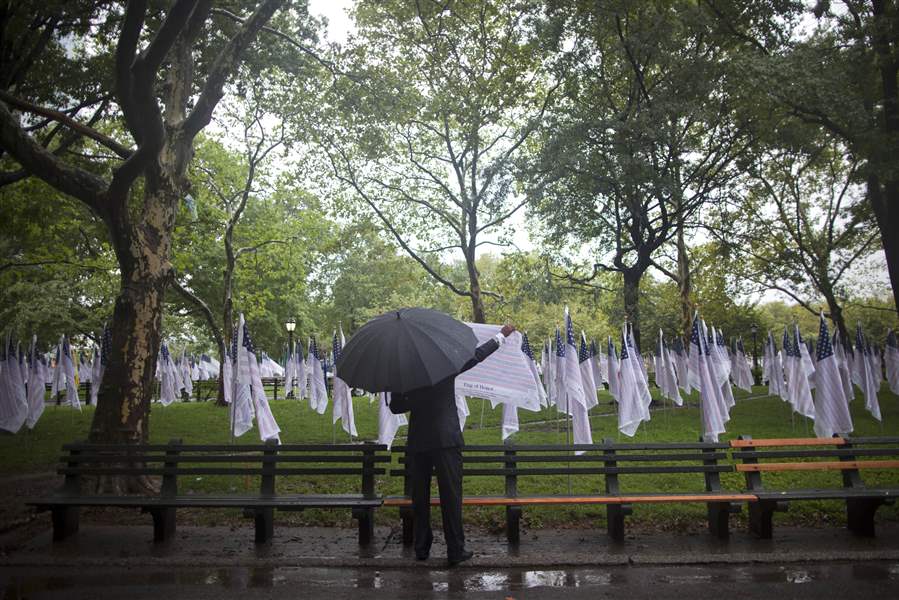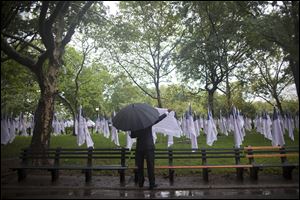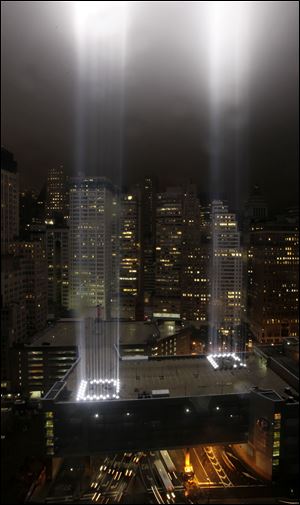
Lower Manhattan rises from the ashes of Sept. 11
9/11/2011
A man reads the names of victims of the Sept. 11, 2001, terrorist attacks, written on U.S. flags as part of "flags of honor" project in New York
ASSOCIATED PRESS

A man reads the names of victims of the Sept. 11, 2001, terrorist attacks, written on U.S. flags as part of "flags of honor" project in New York
NEW YORK -- Out of the ashes of 9/11 has risen a vibrant neighborhood packed with new restaurants and hotels, places to live, and spots to shop, along with many ways to pay respects to an area some worried would never come back.
A decade after the attack on the World Trade Center, Lower Manhattan draws roughly 9 million of the city's nearly 50 million visitors a year, including the area around Ground Zero.
The neighborhood now has 18 hotels with more than 4,000 rooms, up from six hotels and 2,300 rooms on Sept. 11, 2001. For many tourists, it's a must-see, right up there with Times Square and the Statue of Liberty.
"It's a 24/7 neighborhood," said George Fertitta, chief executive of NYC & Company, the city's marketing and tourism arm. "It's a great moment in time for Lower Manhattan."
While local shopping, restaurants, and other attractions abound, remembering 9/11 is the primary focus for many visitors. The new memorial at Ground Zero opens today on the 10th anniversary of the tragedy. A museum will open at the site a year later under a glass atrium, taking visitors 70 feet down on gentle ramps to the very epicenter of what used to be "the pit."
Ans van de Pasch, 49, of Venlo in southeastern Holland, first visited Ground Zero three years ago, peeking through masked fences like thousands of others. This summer, the site is more visible and she brought her husband and two teens.
"There's a different spirit. You can feel the community is back," Pasch said as they walked through the nearby St. Paul's Chapel, where weary firefighters, police, and volunteer rescuers sought refuge during their desperate work in 2001.
She wanted her kids to see the Ground Zero area for themselves. "It's very necessary that you can have one moment in your life when you let yourself, as a citizen of the world, stop and think, 'This must never happen again.'"
Here are some details on visiting the memorial, along with suggestions for other things to do in Lower Manhattan, from intimate tours offered by the September 11 Families' Association to shopping, parks, and restaurants.

A test of the Tribute in Light rises above lower Manhattan. The memorial, sponsored by the Municipal Art Society, will light the sky on the evening of Sept. 11, 2011, in honor of those who died ten years before in the terror attacks on the United States.
NATIONAL SEPTEMBER 11 MEMORIAL & MUSEUM:
The memorial is a big reveal years in the making. Created by design competition winner Michael Arad, who partnered with California landscape architect Peter Walker, it takes up about half of the 16-acre site. Additional office buildings and a new transit hub remain under construction with the museum.
The memorial will be dedicated today during a ceremony for victims' families. It opens to the public tomorrow.
On the twin footprints of the towers are gentle waterfalls that empty into massive reflecting pools edged by bronze parapets with the names of the 2,983 people killed on 9/11 in New York, in a field near Shanksville, Pa., and at the Pentagon, along with victims of the 1993 bombing at the World Trade Center.
When the memorial opens, 225 swamp white oak trees will have been planted around the site. More than 400 are planned overall, creating an urban grove. On the west side of the south pool, bordering a small clearing called the memorial glade, stands the "survivor tree." It's a Callery pear rescued from the rubble and nursed back to health in the Bronx, only to be struck by lightning and survive again last year. President Obama laid a wreath at the tree in May, and new growth on branches that were once almost entirely shorn are thriving.
Access to the site can be confusing as construction continues. Many subway stops, including those at Chambers and Fulton streets, will bring you nearby. Timed tickets (free but required) can be reserved up to six months in advance at www.911memorial.org. Print your tickets beforehand if you can. Enter at the northeast corner of Albany and Greenwich streets for check-in no more than 30 minutes ahead of your reservation.
Through Jan. 8, the memorial is open 10 a.m. to last entry at 7 p.m. weekdays; 9 a.m. to 7 p.m. weekends; last entry at 5 p.m. Jan. 9-March 10.
No restrooms will be available on site until the museum opens in September, 2012. The World Financial Center's glass-enclosed Winter Garden has public restrooms and there are some on the second floor of the Burger King on Liberty Street at Church.
TOURS:
The September 11 Families' Association offers intimate tours led by survivors, 9/11 workers, and loved ones of those who perished.
The tours stop indoors at the World Financial Center buildings for bird's eye views of Ground Zero as the guides tell their stories to groups of 20 or less.
Tours ($10, under 12 free) are offered daily from the Tribute WTC Visitor Center, run by the families' association, at 120 Liberty St. across from Ground Zero. Only groups of 10 or more may reserve a tour in advance; others should check the tour schedule at www.Tributewtc.org and arrive at least an hour before scheduled departure time.
The tours usually include a stop at "11 Tears," a memorial honoring 11 American Express employees who died on 9/11, located in the company's headquarters in the lobby of 3 World Financial Center. Suspended above an 11-sided granite pool is a 600-pound quartz stone, carved into an 11-sided teardrop. Eleven drops of water fall into the pool periodically, creating intersecting ripples. Victims' names and words chosen by their loved ones are etched on the stone.
FIRE DEPARTMENT MEMORIAL:
Next door to the Tribute WTC Visitor Center, outside the firehouse on Greenwich Street at Liberty, is the Fire Department of New York Memorial Wall. The firehouse, home to Ladder Co. 3, Engine Co. 10, lost five firefighters on 9/11, but the wall is a tribute to all firefighters who died. It was a gift from the law firm Holland & Knight and also honors one of the firm's partners, Glenn J. Winuk, a volunteer firefighter and medic from Jericho, N.Y. He helped evacuate the firm's offices near the World Trade Center, then raced to the towers to help. Winuk died when the south tower collapsed.
CHURCHES:
St. Paul's Chapel, a small Episcopal church built in 1766, miraculously survived 9/11 just across the street from the World Trade Center. Through May, 2002, volunteers ministered around the clock to Ground Zero workers at the chapel. Now on display, the exhibit "Unwavering Spirit" includes one of many cots set up with hand-knit blankets and stuffed animals during the harrowing work. A collection of uniform patches paying tribute to volunteers from around the world still smells of smoke. Enter through the graveyard, on Church Street, between Vesey and Fulton.
Part of the same Episcopal parish, Trinity Church at the corner of Broadway and Wall Street was another nearby refuge for relief workers. A sculpture out front was made out of a giant sycamore tree destroyed on 9/11.
MUSEUMS:
Nearby museums include the National Museum of the American Indian, New York Police Museum, the Museum of Jewish Heritage, which honors victims of the Holocaust, and the Skyscraper Museum in Battery Park City.
PARKS:
With 25 acres of waterfront parkland, the Battery is the largest public open space in Lower Manhattan. Pier 25 on the Hudson River in Tribeca between Franklin and North Moore streets has an 18-hole miniature golf course, beach volleyball, picnic lawn, and playground. Near the Police Museum, Old Slip Park is a good place to rest tired feet.
Near Pearl Street, the British Garden at Hanover Square honors 67 British subjects who died on 9/11. Queen Elizabeth II, in long sleeves, white gloves, and hat, officially opened the park in searing heat last July.
WALL STREET:
Never mind the bear market. Stop by for a photo op with the famous bronze charging bull sculpture in Bowling Green Park near 26 Broadway, or dive into the neighborhood's history on a guided tour from Wall Street Walks -- www.Wallstreetwalks.com. All include Ground Zero.